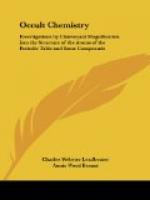The first thing which is noticed by the observer, when he turns his attention to the chemical atoms, is that they show certain definite forms, and that within these forms, modified in various ways, sub-groupings are observable which recur in connexion with the same modified form. The main types are not very numerous, and we found that, when we arranged the atoms we had observed, according to their external forms, they fell into natural classes; when these, in turn, were compared with Sir William Crookes’ classification, they proved to be singularly alike. Here is his arrangement of the elements, as it appeared in the Proceedings of the Royal Society, in a paper read on June 9th, 1898.
[Illustration]
This is to be read, following the lines of the “figures of eight”: H, He, Li, Gl, B, C, N, and so on, each successive element being heavier than the one preceding it in order. The disks which fall immediately below each other form a class; thus: H, Cl, Br, I; these resemble each other in various ways, and, as we shall presently see, the same forms and groupings re-appear.
Another chart—taken from Erdmann’s Lehrbuch—arranges the elements on a curved line, which curiously resembles the curves within the shell of a nautilus. The radiating lines show the classes, the whole diameter building up a family; it will be observed that there is an empty radius between hydrogen and helium, and we have placed occultum there; on the opposite radius, iron, rubidium and osmium are seen.
[Illustration]
The external forms may be classified as follows; the internal details will be dealt with later :—
[Illustration: PLATE III.]
1. The Dumb-bell.—The characteristics of this are a higher and lower group, each showing 12 projecting funnels, grouped round a central body, and a connecting rod. It appears in sodium, copper, silver, and gold,[17] and gold is given (1 on Plate III) as the most extremely modified example of this form. The 12 almond-like projections, above and below, are severally contained in shadowy funnels, impossible to reproduce in the drawing; the central globe contains three globes, and the connecting portion has swollen out into an egg, with a very complicated central arrangement. The dumb-bell appears also in chlorine, bromine and iodine, but there is no trace of it in hydrogen, the head of the group. We have not met it elsewhere. It may be remarked that, in Sir William Crookes’ scheme, in which they are all classed as monads, these two groups are the nearest to the neutral line, on the ingoing and outgoing series, and are respectively positive and negative.




